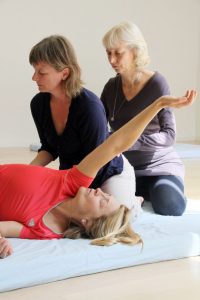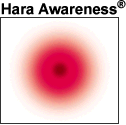Katsugen Undo: Order and Spontaneity in “Moving Zen” (Interview)
 An interview by Ishu from the German Osho Times with Prem Anando on Katsugen Undo. It is part of the holistic healing method Seitai, from the Japanese Healer Haruchika Noguchi.
An interview by Ishu from the German Osho Times with Prem Anando on Katsugen Undo. It is part of the holistic healing method Seitai, from the Japanese Healer Haruchika Noguchi.
What is Katsugen Undo?
Katsugen Undo is Japanese and means: “movement from inside” or “life renews itself from the source”. That is why they are also called “regenerative movements” or “regenerative exercises”. The word exercise though, creates a wrong impression, it implies that you could “do it” or “make it” happen. It rather is a method to invite the body into spontaneous movements. They regulate the energy flow of “Ki”, of life energy within the body and soul, balance the nervous system, open the joints and body posture, all of which is an expression of our psyche. Noguchi developed different exercises that invite the spontaneous movements, open blockages in vital parts of the body or bring balance to the “ki” flow. For us, humans, it is not easy to allow spontaneous movements even though they are part of our nature. For instance, a cat or a dog naturally like to stretch their bodies after having a little nap. And you can see them doing it effortlessly, full of grace and elegance. If we humans stretch while doing exercises, it has more the look of forcing the body to do something. We have lost the effortlessness and flow in the movements. Also when you watch young children, you can still see them make all kind of movements that are not necessarily connected to a purpose or an aim. Their movements still happen from within as a union and out of the connection to the natural self-regulative forces of the body and psyche.
In the course of our educational years we mostly loose this natural ability to move effortlessly. Instead our movements mostly have an aim and are being controlled by our mind and therefore carry a high level of tension in the body tissues.
What are actually spontaneous movements?
Spontaneous movements are not ordered by our willpower. Simple examples for spontaneous movements are yawning, breaking wind and burping, releasing air from whichever body openings or stretching ourselves while getting up. In these ways the body naturally tries to balance itself and unwind tensions held in the fasciae. The fasciae, the connective tissue in the body store the somatic memory of the body: emotions, that we denied or inner impulses we held back, “undigested” traumas or accidents also form a residual tension in the body. In a way, they twist the fasciae and the body posture. The natural tendency of the body is to unwind and go back into its natural order, but we have become in a way too “civilized” to allow it. So sometimes at night, when we toss and turn in bed, this is the bodies natural tendency to try to take advantage of our control system being asleep.
Many of Oshos Meditation Techniques give room for spontaneous movements like for instance in the dancing phase of Kundalini meditation. Instead of making a show dance, the idea is to allow the body to do its own movements…. movements from within.
That is correct in a way, it is spontaneous, but still influenced by the music of the meditation. Even though these movements are supported by the music, more and more people nowadays find it difficult to allow them to happen. There often is shame about allowing the spontaneous expression of our Inner to become visible. We have lost the trust. So Katsugen Undo tries to make bridges to regain the trust in ourselves and in finding our natural flow again: different meditation techniques and exercises reconnect us to the sensitivity to our own impulses and open the body, free it from control in order to allow the spontaneous. This helps us to find a different kind of balance in body, psyche and mind. Instead of believing in holding, controlling and willing by creating immense tension, we can find a balance in ease between order and spontaneity. This will lead us into a space beyond our personality. Our personality is an adaptation response to our environment, which last and not least has disconnected us from our nature and from the regenerative force of life energy, the “Ki” of the universe.
If I understand correctly, it is the personality in contrast to the regenerative forces of the life energy “Ki”? How does the personality influence the body?
The personality makes a certain “twist” in the body. There are different types of personalities and therefore different types of “twists” or holding patterns in the body. If you are an experienced Seitai practitioner you can see by the way someone is walking into a room, which type of character tendencies are prevalent. For example if you are the “fighting” type you have the tendency to twist your hips, shoulders and chin while walking. Just remember the scene in a pistol showdown of a Western movie like “High Noon”. The cowboys are walking with the hips moving and turning from side to side. That’s the twist of the fighting personality. Each personality structure shows itself in the body. The body reveals how you “fall out of” your centre. Each personality type is a one sided overdoing of, what in itself is, a natural and important tendency and capacity. So the ability to fight and stand your place is important for coping in life, but we should always be able to go back into our centre. But in our personality we are identified and dominated by the reactive pattern. The personality creates a twist in the body, which always impairs the flow of the life force”Ki” and disconnects us from the centre.
So how do you work with the “twist”?
The study of ones own personality and its tendencies, which are called Taiheki is one way. Another way is practicing “Katsugen Undo” the spontaneous movements, the body opening exercises and meditation techniques which reconnect us to the centre. And yet another way is rebalancing the Ki in the body which is called Yu-ki, a delicate touching the body on an energetic level.
Can you tell us, what you yourself learned about your body and your “Type”
I am the type called “open”. This type has a difficulty in feeling and setting boundaries. This type is very sensitive and open to others, but looses connection to its own needs. This type easily gets distracted and looses focus. The good side is the sensitivity for my work as a therapist: I am able to sense the other clearly and understand them.
I learned how that character type manifests itself in the body, it shows in hips that are too wide open. With certain exercises that close the hips and strengthen the middle line of the body and with the focussing of awareness and letting the inner movement start from there, I can bring balance and discover new sides a myself. When the order in the body changes, the way I perceive myself and therefore my behaviour changes. It is a quite amazing process.
You have mentioned to me before, that also in the School of Centering and Zen Martial Arts, which were part of the Osho Multiversity in Pune, Katsugen Undo classes had been given by a Japanese women. Can you say something about this?
Osho had encouraged us in his last two years to use all the best from what each tradition had to offer. That is why he had opened different schools in the Osho Multiversity in Pune. In a way he encouraged us to learn from each other as each sannyasin therapist who had come to the school of centering had brought different skills from all over the world. But also other teachers were invited. So in the beginning of the 90-ties this Japanese Women, unfortunately I do not remember her name (too long ago), was invited and she made me very curious, to learn more about this technique. Since then I have practiced with other teachers who had learned from students of Noguchi and finally after many years I had found an original Japanese woman teacher Mutsuko Nomura Sensei authorized by Noguchi with whom I have been studying intensively since 2005.
In the last two years of Osho’s discourses he was pointing out again and again the supremacy of Zen as a religionless religiousness, a direct experiencing of yourself in your centre. It was only later that I understood, that Katsugen Undo was also called “Moving Zen”, which explained my attraction to the technique. In that, connection to your centre and allowing the movement from within, brings us into a unity with ourselves, the universal life energy, which is an alive moving silence.
This movement from within seems to be something natural, why do we need to practice it then?
When you see young children, you can still see that unity in them. The development of life and the body of the unborn in the womb is a growth in the form of expansion and movement. This expansion and movement that happens from the inside continues after birth in the form of exploring movement into space, touching and holding things and of expression of all the feelings and needs a baby or small child has. Growth of body and intellect are one, in the form movement. It is an intrinsic need of ours to grow and develop. For the unborn there are two basic experiences growth and connectedness.
A baby grows without being frustrated about how many times it has to move an arm and the fingers to be finally able to hold a small item in its hands. It is content with curiously exploring things. Prof. Dr. Gerald Hüther, a German neuroscientist calls this an intrinsic motivation to grow and participate in the creativity of life. Unfortunately he says this intrinsic motivation is dampened by our school system and the way we as grown ups think we have to explain and show everything to a child and tell it how to do things correctly or better. Too many instructions from outside make us loose the inner motivation and joy that is in exploring.
In an experiment scientists discovered that, when a child gets corrected and shown the right way to put one block on top of the other to make a small tower, it stops for a few seconds before it starts exploring again. The more often it gets interrupted and shown how to do it “correctly”, the more time it needs to come back to the exploration. If the corrections are too many at some point it stops completely. It loses the intrinsic motivation and joy of exploring and starts to look at the outside for orientation on how to be, how to do this and that. At the age of 8 most children have lost their intrinsic motivation, says Prof. Dr. Gerald Hüther.
This loss of intrinsic motivation creates a deep frustration and sense of being lost later as a grown up in life.
Reconnecting with the inner movement and trusting it again helps us to come back to a unity with ourselves. Then playfully growing and expanding in life can fulfil us again. Life is not about reaching certain goals.
